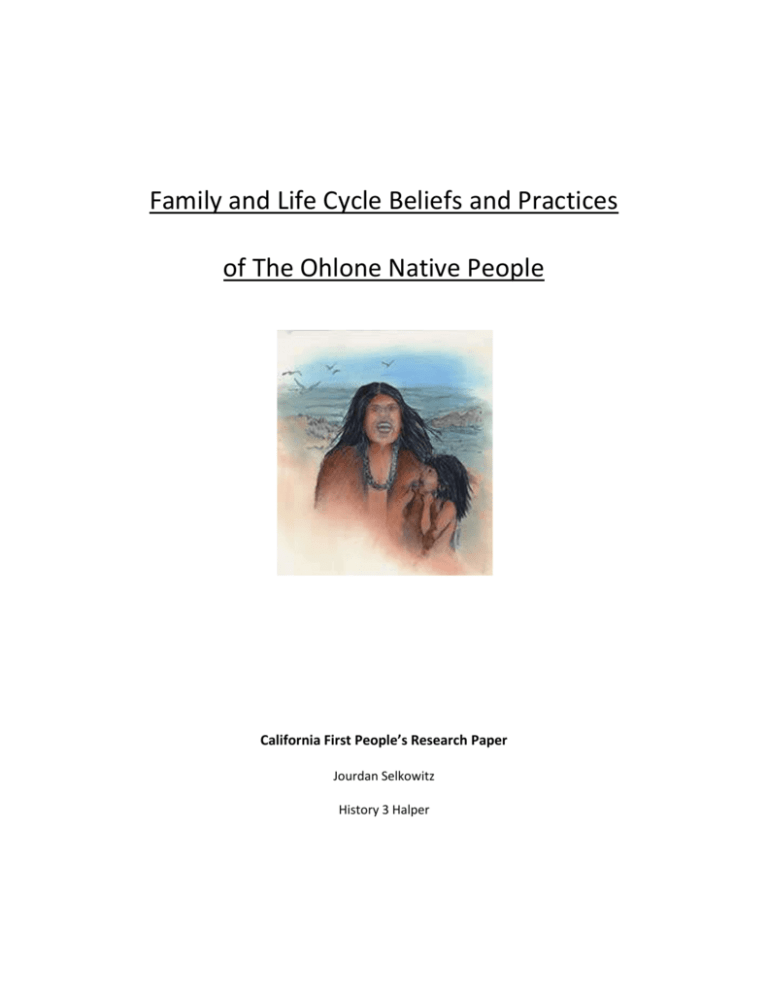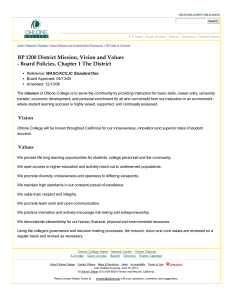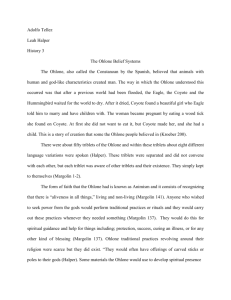The Ohlone Family and Lifecycle
advertisement

Family and Life Cycle Beliefs and Practices of The Ohlone Native People California First People’s Research Paper Jourdan Selkowitz History 3 Halper Ohlone People From Monterey to San Francisco The Ohlone, a group of California native Americans, lived a peaceful subsistence based lifestyle in central California for hundreds of years prior to the rise of the California Mission system in the 1770s. The term Costanoan, which is derived from the Spanish word Costenos, meaning “coast people,” is used interchangeably with Ohlone and identifies native people who lived along the coast from Point Sur north to San Francisco and inland to the Diablo Range. Eight identified common languages were spoken amongst them (Levy 485). These were the Karkin, Chochenyo, Tamyen, Ramaytush, Awaswas, Mutsun, Rumsen, and Chalon (485). There was also fifty different tribelets, or individual divisions of the eight language groups (485). Ohlone people lived on land presently known as Monterey, Carmel, San Jose, Santa Cruz, San Juan Bautista, and Berkeley (485). Family Beliefs Ohlone families averaged in size from 10-15 people per household (Halper). Every person from birth to death was bound to their family, clan, and tribelet (Margolin 72-73). It was their purpose to strengthen these bonds over their lifetime; to tie themselves down and tie others to them. Belonging gave them a sense of strength, joy, fulfillment, identity, security, and purpose (Margolin 72-73). People lived communally and valued generosity and sharing. When a hunter killed a deer for example, the meat was first shared with family and community members, sometimes the hunter received none (Margolin 89). Through sharing, individuals strengthened their place in the family and tribelet and could count on their support and security in times of need (Margolin The 89). It was a reciprocal system in which people cared for one another. Child Raising Beliefs From the first day of life an Ohlone newborn began on a lifelong journey of commitment to family, community, and to learn the Ohlone way just as ancestors did for hundreds of years prior (Margolin 7273). The child was taught one way, that there is no other successful way of living but their own and wasn’t even able to imagine life otherwise. An Ohlone child grew up seeking not to improve, innovate, or rebel against his parents, instead, he or she understood that the best ways were the old ways and that the greatest wisdom in life came from passing on the way of his tribelet, elders, and Coyote. Ohlone people did not want their children to grow up as independent, unique people. Freedom and individualism were unimaginable ideas. To achieve freedom was to become weakened, damaged, and greatly vulnerable. Children were raised to be obedient, moderate, and cooperate (Margolin 72-73). Pregnancy and Early Years Pregnancy was a very important time for an Ohlone woman and her entire tribe. There were many beliefs, rituals, traditions, and taboos surrounding pregnancy and it was a time of great vulnerability for all. Strict dietary rules applied not only to the woman, but also to the man. No meat, fish, or salt could be consumed by the wife in order to not have a large baby and a difficult childbirth (Margolin 67). The husband was excluded from consuming meat, salt, and tobacco. Behavior was carefully regarded as well. Both the man and wife were to be especially aware of treating people and animals with respect. Even the man’s hunting duties were relieved during this time. The woman was instructed not to scratch any itches she might have on her belly for it would make her wrinkled and ugly. Another taboo was the restriction of using an awl in basketmaking for the poking of it could make the baby blind. Following the proper way during pregnancy was so important because a deformed baby, or even twins, were considered to have evil powers and were killed (Margolin 67). The day a woman went into labor brought the help and support of the village women (Margolin 68-69). A midwife was considered to have extraordinary powers and could employ them should difficulties arise. She turned to the powers of her sacred medicine bundle during this time. It was important that none of the other women looked directly at this bundle and caught a glimpse of its contents. One item that it likely contained was a bear claw, which when rubbed over the woman’s belly and legs, gave her great strength with which to push out the baby (Margolin 69-70). It was very important that after the birth, the umbilical cord be taken, burned, and disposed of properly so that no harm would come to mother and baby. Both also washed in a cold stream after birth according to tradition (Margolin 70). The husband made a fragrant and soft mattress of herbs laid over warm coals where mother and baby rested for the next week (Margolin 70). After the first week, the baby was settled into a cradle which relatives lovingly made and decorated with beads and feathers (Margolin 71-72). It was here, swaddled tightly in rabbit skin, that the baby spent the first two years of its life listening and observing the Ohlone way (71-72). It was important for the mother to maintain her diet and have no physical contact with her husband while the child was still nursing (71). It was believed doing so spoiled the mother’s milk (Margolin 18). Childhood The child was weaned and released from the cradle by the age of two and quickly learned to walk, run, and play with other boys and girls (Margolin 73). By age six the child was expected to contribute to the efforts of the family in any way possible such as picking berries or helping siblings carry home the day’s catch (74). By age seven or eight, the child had already accumulated vast knowledge of plants and animals as well as an understanding of the duties and expectations of family and community (74). The child obtained a solid mindset that there was only one Ohlone way (74). Boys and girls were also separated around this age in order to spend more time with their elders learning their gender roles (74). Puberty into Adulthood The transition of a boy into a man was a gradual process (Margolin 74). Boys spent their time in the company of the men learning how to hunt, fish and craft stone and wood. Much time was spent in the sweathouse and through his learnings and participation with elders, the boy eventually became a man (74). Girls similarly spent time with their female elders. They gathered plants and learned songs and the complex skill of basket making (Margolin 75). They received tattoos which were mostly decorative except for the lines and dots on the face which were marks of tribelet and lineage and would tell prospective men if they were of compatible lineage (76). In contrast to the gradual adolescent process of boys, girls specifically, and rather abruptly, became a woman at the completion of her first menstruation (75). Menstruation was a time filled with significant beliefs and rituals like so many aspects of Ohlone life and it was believed that how a girl acted during this time would affect her for the rest of her life (75). The girl at the onset of menstruation was forced to reside in a corner of her dwelling and in some cases, a separate hut built specifically for the occasion (Margolin 75). Her use of cold water was considered taboo as well as consuming meat, fish, and salt. She was also obligated to take ritualistic baths. The women of the village counseled her on proper behavior during this time and questioned any dreams she may have had. Members of her family performed sacred dances and songs. When not visited by family, she was left alone with her own feelings of fear and confusion but had to try to behave and think as properly as possible (75). She may have entered the hut as a girl, but by the end, she most certainly immerged a woman (75-76). Dressed in beads and fine feathers, she was now treated as an equal amongst the other women and a feast in her honor celebrated her new role (Margolin 76). Marriage Marriage in Ohlone society was highly valued although customs surrounding it were informal and relaxed (Margolin 83). The process began like most marriages with two people falling in love. The male then made a request of the girl’s family for an approval of their marriage (78-79). If a positive decision was reached, the man’s family then offered gifts to her family such as baskets, beads, featherwork, and furs. The quality of these gifts were associated with the quality of life the woman could expect in her new marriage. Preparation and feasting lasted for days after which the couple went to live with the bride’s family for the first few months in order for the groom to prove himself hardworking, honest, and skillful to the bride’s family (81). It was important that he abide by the taboos such as not making eye contact with her parents and speaking to them in third person but only out of necessity. Even doing this caused great shame and embarrassment (81). After this trial period, the newlyweds went to live with the groom’s family (83). The Ohlone were very selective of their marriage partner and strict criteria needed to be met. The partner could not be a member of their own family which meant that men from small villages had the difficult task of trying to meet women at local dances or trading events (Margolin 86-88). Blood was not the only consideration, however. A man was also expected to marry from his outside his clan as well as his moiety. If he was a bear, he must marry a deer. These restrictions posed serious challanges to finding a mate. The man would have to form relationships with neighboring tribelets although there was constant tension between them (Margolin 87-88). The values the Ohlone placed on marriage are not dissimilar to those of modern day societies. Fidelity was expected although their commitment might be tested at times (Margolin 83, 85-86). Infidelity was often handled with violence and reprimand. Despite marital issues, every attempt was made to keep couples together. If one became lazy or unfaithful in the relationship, pressure was felt from both families to make improvements (83). As a last resort, divorce was acceptable although it made both parties less attractive to future mates. In the event of a divorce, the children would live with the mother (Levy 490). Sex and Sexuality The Ohlone, like most California Native Americans at the time, held beliefs about the time and conditions under which one can have sex. They believed love making robbed one’s spiritual energy and that too much indulgence would leave a person unfit for rigorous spiritual activity (Margolin 85). Therefore, sex was abstained from when preparing for any event of spiritual importance such as a dance or ceremony. It was also taboo to have sex when a woman was menstruating, nursing, or before a man was getting ready to hunt deer (85). Practicing abstinence while nursing practically meant that a woman’s children would be spaced out at advantageous intervals. The high infant mortality rate and the performance of abortions (which the women knew how to induce) played a role in birth control and therefore, in population control (Margolin 85). Homosexuality was accepted and the people had a flexible understanding of it (Margolin The 84). It was not as prevalent in Ohlone society as in the Chumash who were likely to have three homosexual couples living within one large village. However, it was still common. There were known cases documented by Spanish explorers of two men living together in the same hut, one of which who chose to dress like a woman and followed a woman’s role. Some boys followed the same path as girls as they grew up and even got married to men just the same. It was also acceptable for women to be homosexual but only practically speaking as they were not allowed to adopt male roles (Margolin 84). Death Customs Just as we feel anguish and pain with the loss of a loved one, the Ohlone experienced tremendous grief and sadness with the death of a village member as each person had a special place in the community (Margolin 145). Even before the loved one actually passed away, family and villagers were grief stricken knowing that the death was inevitable (145). The village shaman was involved in the dying process, having received gifts from the family to help make a cure. Once the shaman’s curing ceremonies became futile, some of the beads and skins given by the family were returned (145). The corpse was buried or cremated on the day of death (Levy 490). In the San Francisco Bay area, cremation was common especially amongst the Chochenyo and Ramaytush unless there existed no kin to gather the necessary firewood, in which case a burial occurred instead (Levy 490). The Chalon and Rumsen tribelets of the Monterey Bay area were known to bury their dead (Levy 490). Cremation was reserved only for those of power such as chiefs, shamans, and warriors (Margolin 147). Despite overwhelming grief, proper ceremonies had to be performed. If not, it was believed the ghost of the deceased would be angry (Margolin 145). At the time of death, messengers were sent to the surrounding villages to gather people to join in the mourning ceremonies. In preparation of cremation, family and friends gathered the necessary firewood for the funeral pyre. Others prepared the corpse by adorning it with feathers, flowers, and beads. The body was tied in a flexed position with knees tucked under the chin and hands on the cheeks. It was also important that every material possession of the deceased be collected and burned or buried with the body (Levy 491). All possessions including one’s bow, arrows, blankets, dance regalia, and even one’s hut needed to be destroyed (145). This tradition stemmed from the fear that the “ghost” of the dead would be drawn not only to family and friends, but also to its old dwelling and belongings (Margolin 147). The guests also threw their valued beads, baskets, and featherworks on the pyre to offer as gifts to the dead. “All the guests mourned piteously, stopping their wailing to dance periodically around the pyre with a slow, measured tread, then resuming the wailing once again” (147). The Ohlone like most California Indians of the time had a great fear of ghosts. “At the time of a death, figures from the spirit world mixed closely with the villagers. These were dangerous times: the people, especially the widow, were extremely vulnerable” (Margolin 145). Although the body no longer existed, the soul still did, and it was greatly feared that the ghost would hang around and cause damage instead of journeying to the land of the dead. This is illustrated in a Yokut funeral chant which goes: “You are going where you are going: Don’t look back for your family” (Margolin The 148). It was believed that after death, the soul travels to the land of the dead as described in this Chochenyo narrative: “The Chochenyo journey to the land of the dead includes a stop to drink water and eat panocha (native sugar). A road leads to a sea foam which the dead pass through. The Chumash soul’s journey to the land of the dead, although different in some ways, includes a road and several stopping points” (The Ohlone Past 140). It was believed the deceased would be greeted at the island of the dead and that there he/she would eat, dance, and sing with the other spirits (Margolin 147). The widow of an Ohlone man was especially affected by the death of her husband. She expressed her overwhelming sense of sadness and grief with shrill wailing and screaming, and beat herself on the breasts with a pestle (Levy 491). She also tore at her face and breasts with her fingernails until her skin bled (Margolin 147). The widow was regarded as being the most vulnerable to the ghost of her husband (Margolin 148). She was seen as a potential conduit for evil powers because of her closeness with him. In order to make herself unrecognizable and unattractive to her husband’s ghost, the widow singed her hair with live coals or cut it off with a knife and smeared ashes on her face (Levy 490-491). The period of danger lasted from 6 months to a year during which she lived in confinement from the other villagers who sought to avoid her (148). They were also fearful to dream of the deceased as a dream of the dead was the same as being visited by their ghost (148). An annual mourning ceremony was held to remember members of the village who had died that year and dances and feasts were held in their honor (Levy 491). It was only after the passing of a year that life returned to normal for the widow and that she could grow her hair and marry once again (Margolin 148). Although the pain of losing a loved one never fully disappeared, it was strongly taboo to mention the dead by name (Margolin 148). It was considered very disrespectful to talk about deceased parents and relatives (149). “Her father is dead. …Now she must never mention his name, she must try not to think about him. He is dead (Margolin 18)”. Their names were not spoken until the name was given again (Levy 491). Because of the taboo against naming the dead, the Ohlone had no way to record or remember their family history. Their sense of geneaology was vague and only extended back a few generations. “A person would know, for instance, that his or her great-grandfather was of the bear lineage without knowing much else about him. Beyond that, history did not exist” (Margolin 149). No one built lasting monuments to survive them and within a few generations time, the memory of an individual was lost also (149). The Mission Period Contact with Spanish settlers and the arrival of the mission system initiated the demise of the Ohlone people and the culture that was sacred to them. The Rumsen were the first Costanoan group to be encountered by the Vizcaino exploring expedition of 1602 (Levy 486). However, it wasn’t until 1770 when Father Junipero Serra and Gaspar de Portola arrived in Monterey that the Ohlone way come under threat (Breschini). Seven missions were established within Ohlone territory under the direction and vision of Father Serra (and his successor Fermin Lasuen) between 1770 and 1797 (Levy 486). The mission system, described by Edward Castillo as “a scheme of world conquest devised by the Roman Catholic Church and the empire of Spain (Castillo 272),” was supposed to only be a 10 year endeavor of which the natives were to become the beneficiaries. Instead it became almost 70 years of slavery, dehumanization, and cultural genocide for the Ohlone and California native people alike (Castillo 272). The curiosity and novelty of Spanish foreigners as well as the hope of establishing profitable trade relations drew natives to the missions voluntarily at first (Margolin 160). Unfortunately as the missions filled to capacity, living conditions and treatment declined rapidly and dramatically. Upon arrival at the missions, natives were quickly urged to accept baptism even though a significant portion of the Christian doctrine was lost in translation (Castillo 281). With baptism came the complete loss of freedom and adults who refused it saw their children baptized in an effort to attract them as well (Margolin 160). Chiefs were also the target of baptisms in hopes that their entire tribelet would follow (160). Most natives were unwilling to learn the church doctrine. To make matters worse, all masses and sermons were held in latin and natives were prevented from using their own languages (Margolin 162). Indians started to die in high numbers of newly introduced European diseases such as measles, mumps, smallpox, influenza, and syphilis, to which they had no immunity (Margolin 163). The devastating spread of these diseases was exacerbated by overcrowded and unsanitary living conditions (163). In 1806 at Mission Dolores in San Francisco, a measles epidemic killed over 300 people out of a population of 1000 and because of chastity regulations keeping men and women apart, only 23 infants were born alive that year (163). The Ohlone population was about 10,000 in 1770 at the start of the mission system. By 1830, this figure dropped to less than 2,000 (Levy 486). The Franciscans were shocked by the natives’ partial nudity and uninhibited sexuality, and took “draconian measures” to encourage female neophytes to conform to their beliefs of proper behavior (Castillo 282). Female children over the age of five as well as older unmarried women were locked in quarters called monjerios immediately following their baptism (Castillo 282). Mission visitors were overpowered by the stench and filth of these prison-like buildings (Castillo 282-283). Women and children were also raped by the soldiers and often induced abortions for pregnancies resulting from these rapes (Castillo 283-284). Soldiers were stationed at or near each mission to keep order and apprehend any neophytes who might try to escape (Margolin 160). The Franciscans used methods of stocks, extra work, imprisonment, and lashings to punish those they felt had transgressed (Castillo 282). Women were also subject to physical punishment as French explorer La Perouse noted: “Women are never whipped in public, but in an enclosed and somewhat distant place that their cries may not excite too lively compassion, which might cause the men to revolt” (Castillo 284). For the native Ohlone, life in the missions proved to be psychologically disastrous. Early visitors to the mission such as Russian explorer Otto Von Kotzebue, described a persistent look of deep melancholy on the faces of the natives (Margolin 164). Louis Choris remarked about the absence of laughter (Margolin 163). Even Captain Vancouver noticed that they “carried on with mechanical, lifeless, careless indifference” (164). What was once a thriving, independent and self-sustaining community of Ohlone, was now transformed into a slave society whose people died not only physically, but also spiritually. Although the Ohlone were periodically permitted to revive certain native practices, the overall state of oppression irrevocably damaged hundreds of years of native culture (Margolin 164). Knowledge of basketmaking and other basic crafts were lost as well as rituals and dances that became muddled by the mixing of native groups from a widespread area. Language was often dropped in favor of the dominating mission group (Margolin 164). Although the mission system ended in 1834, life scarcely improved. Those who survived went to work on nearby ranches and tried to blend in to escape further persecution (Levy 486). Culture and traditions neared extinction as old people died and the young moved away (Levy 487). The arrival of Anglo settlers and the Gold Rush frenzy further insulted Ohlone attempt at freedom and tradition (Margolin 166). It is only through the efforts of today’s Ohlone people that their cherished history and beliefs are preserved and kept alive.






